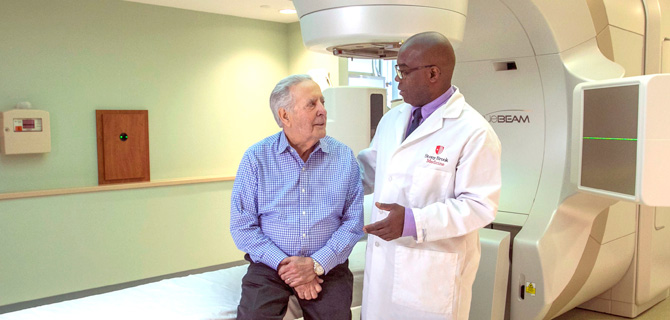What are stereotactic radiosurgery and stereotactic radiation therapy?
Stereotactic Radiosurgery (SRS) and stereotactic radiation therapy (SRT) are advanced and modernized forms of radiation therapy. They allow us to deliver high dose radiation to a small focused area. This specialized form of radiation treatment involves a team of specialists. This team includes radiation oncologists, radiologists, radiation physicists, radiation therapists and nurses, and other specialty doctors.
How does stereotactic radiation therapy work?
Stereotactic radiation therapy and radiosurgery are ultra-focused radiation to the tumor only. The treatment controls the growth of a tumor or abnormal cells by either killing the cells directly or by disrupting the ability of the cells to grow.
SRS and SRT are very similar, but SRS delivers a large dose of radiation on a single day and SRT has a fractionated treatment schedule. This means that in an SRT treatment the patient will have treatments spanning multiple days. Although, the total dose in SRT may be larger than in SRS any single day will have a much smaller dose delivery. Both are used for the treatment of localized tumors in the brain and more recently in the body sites, called Stereotactic Body Radiation Therapy (SBRT) or Stereotactic Ablative Body Radiation (SABR).
Due to the large dose delivered in SRS and SRT, it necessitates a very precise positioning of the patient. To accomplish this a special mask or position device is made for each patient at the time of CT is taken. This enables the accurate positioning of the patient which allows for the delivery of radiation on the sub-millimeter scale.
How is the mask or position device made?
- Your first appointment to prepare for your treatment is to make the mask. This will take about an hour.
- The mask is made from a mesh material called aquaplast. A piece of aquaplast will be molded around the back of your head. Another piece will go across your forehead and between your nose and mouth. A special piece of aquaplast forms a mouthpiece that will be fitted over your two front teeth. The other two pieces will be molded across the nose and over your face. The mask will not interfere with your breathing. The aquaplast is placed on your head, face, and neck. It is warm and soft at first. While you lay comfortably flat, the mask becomes firm, contouring your head, face, and neck. Depending on the area treated, an individualized body position device will be created.
- It will take about 30 minutes to complete. During this time, you will be asked to remain very still.
- Once the mask or body position device is cool, it will be removed, ready for daily use.
What happens to prepare for my treatments?
- You will need to have a CT scan and/or an MRI before your treatment. The MRI and/or CT scan may be done a week before or a few days before your treatment.
- You will also have another special CT scan done in the Radiology or Radiation Oncology Department for the purpose of radiation treatment planning. During this CT scan, you will have to wear your mask.
What happens during my treatment?
- You will be given a specific time to come for your treatment.
- The therapists will call you into the radiation treatment room where you will be asked to lie on the treatment table.
- To limit any movement of your head during the treatment, you will be positioned in your mask. The therapists will make you comfortable using knee pillows and blankets.
- The therapists will then position the treatment table so the prescribed treatment can be given accurately. The set up is complex. It is important that you remain very still.
- Once everything is set up, the therapists will leave the room. The treatment robotically performed from a computer set up outside your treatment room. The therapists can see and hear you at all times. You will be able to communicate with them through the intercom. They can interrupt the treatment and enter the room at any time if needed.
- If you are anxious, coughing, or in pain, it is important to take appropriate medicines to help minimize movement.
- You will not feel the radiation during your treatment but you may hear the accelerator working. You may see or hear the accelerator as it moves but it will not touch you.
- The therapists may come into the room at times during your treatment to re-position the accelerator. The treatment is delivered from different positions so you may feel the treatment table move.
- The actual treatment time is about 10 minutes. You will be in the treatment room for approximately 30-60 minutes which including treatment and repositioning to ensure the quality of treatment.
- Each day you will be given the time for your next treatment.
What are the side effects?
- Most patients have very few side effects. Please ask your doctor about the possible side effects involved with your specific treatment.
- Some patients find the mask snug during treatment and it can leave a temporary pattern on the skin.
- Some patients may experience some short-term side effects, such as headache, gastrointestinal upset, or fatigue.
- If you have any problems, please let your treatment team know.
How many treatments will I need?
Your doctor will let you know how many treatments you will need and what your treatment schedule will be. Treatments are given daily Monday through Friday, but it can start or finish on any day of the week.
What happens after the treatments are finished?
After your last treatment, your nurse will review any important instructions with you. You will be given a follow-up appointment. This follow-up visit may include tests such as a CT scan or MRI.


